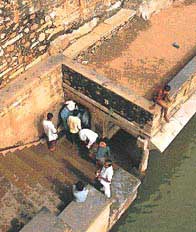Departure from tradition
 The total area of Chittor fort is about 500 hectares (ha). The average depth of the reservoirs is about two metres, and with the total area of all reservoirs inside the fort being roughly 200 ha, they can owe about four billion litres (l) of water. Total rainwater that can be collected, failing over an area of 400 ha with an average annual rainfall of 700 mm, amounts to a respectable three billion litres. The total water that will be consumed per year by 30,000 people with a daily consumption of 20 l/day/person, would be about 0.2 billion litres.
The total area of Chittor fort is about 500 hectares (ha). The average depth of the reservoirs is about two metres, and with the total area of all reservoirs inside the fort being roughly 200 ha, they can owe about four billion litres (l) of water. Total rainwater that can be collected, failing over an area of 400 ha with an average annual rainfall of 700 mm, amounts to a respectable three billion litres. The total water that will be consumed per year by 30,000 people with a daily consumption of 20 l/day/person, would be about 0.2 billion litres.
These figures show that the builders of these reservoirs had provided even for extreme contingencies. In a year when the rainfall would be more than the normal, water could be stored for next year. in cow of a prolonged siege of one two years, the inhabitants of the fort could survive even if the monsoons failed. Even after losses from seepage and evaporation and water demand of animal an army of about 50,000 people could live in the fort for nearly four years without any fear of dying of thirst.
But modern human behaviour is not equally ingenious. Chittor fort is one of the few forts in the country in which about 3,000 people reside even today. The state's public health engineering department (PHED) supplies 67,500 l of water daily - from tubewells and dugwells in the plains below - to the residents of the fort. But the modern town of Chittor, at the foothill of the fort, has been facing water shortages for the last few years. The water needs of the people in the fort can be easily met from the existing sources In the fort Itself. But PHED engineers believe that water in the fort, which had been consumed by the royalty and their armies for centuries, is not of good quality. Ironically, during times of water shortage in Chittor town, water from the fort is Still tapped.
